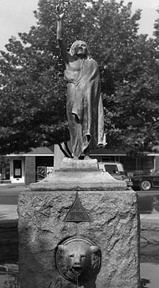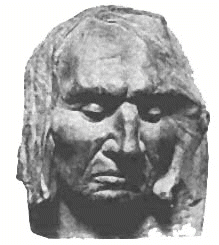|
|
||
 |
Chief Seattle, according to historian Clarence Bagley |
|
“Chief Seattle and Angeline,” an article by early Seattle historian Clarence B. Bagley (published in the Washington Historical Quarterly, Volume 22 #4, October, 1931) provides a detailed look at Chief Seattle’s life.Bagley mentions Seattle’s father, Schweabe, Seattle’s two wives and several girlfriends, and his daughter, Angeline, by his first wife. Pioneers erected a monument to Chief Seattle in 1892, after his death, and estimated the year of his birth to be 1786.The article describes Seattle’s friendship with Doctor David S. Maynard, considered the founding father of the city of Seattle. Doc Maynard crossed the plains in 1850, ending up near what is now Olympia, the state capitol of Washington. Maynard became friends with Seattle, who told him of a better place than Olympia, with a good harbor. Bagley writes, “Maynard took Seattle at his word, sold off as far as he could his stock of merchandise, put the remainder on a scow, and with an Indian crew and Chief Seattle as pilot, came to the promised land. This was in the last days of March, 1852….Undoubtedly the friendship of Doctor Maynard for Chief Seattle led to the bestowment of his name upon the newly born city.”Bagley quotes Samuel F. Coombs, who describes an “intelligent looking Indian who could speak English.” Bagley says he was told that Seattle became the leader of the six tribes after raids on Seattle’s tribe by White Rivers Indians in 1800. Bagley also describes the arrival of Washington Commissioner (later Governor) Stevens and Seattle’s famous speech to him.Bagley also describes Chief Seattle’s religious conversion. “Through the efforts of the French missionaries Seattle became a Catholic and inaugurated regular morning and evening prayers in his tribe, which were continued by his people after his death. He died June 7, 1866, at the Old Man House from a fever or ague. His funeral was attended by hundreds of whites from all parts of the sound, and G.A. Meigs, of the Port Madison mill, closed down the establishment in his honor. He was buried according to the rites of the Catholic Church with Indian customs added.” |
|
|



